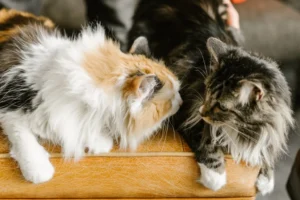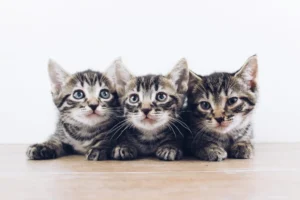Cats and dogs are often portrayed as sworn enemies, with cartoons and movies depicting their constant battles. But why are cats mean to dogs? In this blog post, we will explore the reasons behind this behavior and shed light on the fascinating dynamics between these two popular pets.
Natural Instincts
Cats and dogs have different natural instincts that can sometimes clash, leading to conflict between them. Cats are typically more solitary animals, whereas dogs are more social and pack-oriented. This fundamental difference in their instinctual behavior can create tension in their interactions. Cats may see dogs as intruders in their territory, triggering defensive and even aggressive behavior.
On the other hand, dogs may view cats as prey due to their smaller size and quick movements. This predatory instinct in dogs can make them chase or intimidate cats, further exacerbating the situation. Understanding these inherent differences in their instincts is crucial in managing their interactions and preventing conflicts.
Territorial Behavior
Territorial behavior is a significant factor that can make cats mean towards dogs. Cats are known for being territorial creatures who establish and defend their territory vigorously. When a new dog enters their space, cats may feel threatened and act out aggressively to protect their turf.
Cats also have a strong sense of scent, and when they detect a dog’s smell in their territory, it can trigger their territorial instincts. This can lead to behaviors like hissing, swatting, or even attacking the dog. It’s essential to provide both animals with separate spaces and safe zones to reduce territorial disputes and promote harmony in a multi-pet household.
Additional Insight:
One way to help alleviate territorial issues between cats and dogs is to introduce them gradually and under controlled circumstances. This gradual introduction can help them become accustomed to each other’s presence and reduce the likelihood of aggressive encounters.
Communication Differences
Cats and dogs have their own unique ways of communicating, which can sometimes lead to misunderstandings between the two species. Dogs are more social animals and often rely on physical gestures and body language to convey their feelings. On the other hand, cats are more independent and use subtle cues like tail movements and ear positions to communicate. This communication gap can sometimes result in cats feeling threatened by dogs’ boisterous behavior, leading to defensive or aggressive responses.
Social Hierarchy
In the animal kingdom, social hierarchy plays a crucial role in determining relationships between different species. Cats are known to be more territorial and independent, often perceiving themselves as the dominant ones in a household. On the other hand, dogs are pack animals and have a more structured social hierarchy within their groups. When a cat and a dog are introduced to each other, the cat may see the dog as a potential threat to its territory or status within the household, leading to defensive or aggressive behavior towards the dog.
Unique Insight: Understanding the individual personalities of cats and dogs can also help in deciphering their behavior towards each other. Some cats may be more social and accepting of dogs, while others may be more aloof and wary. Similarly, some dogs may be more gentle and submissive towards cats, while others may be more assertive and playful, leading to different dynamics in their interactions.
Past Experiences
Cats’ behavior towards dogs can be influenced by past experiences. For example, a cat that has had negative interactions with dogs in the past may be more aggressive or fearful when encountering a new dog. On the other hand, a cat that has been raised around friendly dogs may be more accepting and comfortable around them. These past experiences can shape a cat’s perception of dogs and impact how they interact with them in the future. It’s important to consider a cat’s background when trying to understand why they may be mean to dogs.
Personality Differences
Just like humans, cats and dogs have their own unique personalities that can affect how they interact with each other. Cats are known for being independent and territorial, while dogs are often more social and eager to please. These personality differences can lead to conflicts when cats and dogs are forced to interact. A cat that values their personal space may become aggressive towards a dog that invades that space, while a dog that is overly eager to play may unintentionally overwhelm a more reserved cat. Understanding and respecting these personality differences can help create a harmonious relationship between cats and dogs.
Additional Unique Insight:
- Communication Styles: Cats and dogs also have different communication styles, which can sometimes lead to misunderstandings. Cats may use subtle body language and vocalizations to communicate, while dogs may be more overt in their actions. This difference in communication can sometimes result in conflicts between the two species, as they may misinterpret each other’s signals. Being aware of these communication differences can help owners intervene and prevent any potential issues between their pets.
Fear and Insecurity
Cats can sometimes be mean to dogs due to fear and insecurity. If a cat feels threatened by a dog’s size or energy, it may react aggressively as a defense mechanism. Cats are naturally cautious animals, and the presence of a dog, especially a playful or boisterous one, can trigger their survival instincts.
To help address this issue, it’s crucial to create safe spaces for both pets within the household. Provide the cat with elevated areas such as shelves or cat trees where it can retreat and observe the dog from a distance. This allows the cat to feel more in control of the situation, reducing its fear and aggression towards the dog.
Additionally, gradual introductions and positive reinforcement can help cats build confidence around dogs. Rewarding good behavior with treats and praise can create a positive association with the dog’s presence. Over time, the cat may become more comfortable and less likely to act mean towards the dog.
Ways to Improve Relationships
Building a harmonious relationship between cats and dogs in the same household requires patience and understanding. One effective strategy is to establish a routine that includes separate feeding areas for each pet. This reduces competition and territorial behavior, fostering a sense of peace and cooperation.
Another helpful tip is to provide plenty of interactive toys and enrichment activities for both pets. Engaging their minds and bodies in play can help them bond and redirect any negative energy towards more positive interactions. Remember, a tired pet is a happy pet!
Furthermore, consistent training and socialization are key in promoting positive interactions between cats and dogs. Teaching them basic commands and rewarding desired behaviors can enhance their communication and prevent misunderstandings that lead to conflicts.
In addition to these strategies, ensuring each pet has its own space to retreat and relax can prevent tension and promote a peaceful coexistence. By respecting their individual needs and boundaries, you can create a harmonious environment where cats and dogs can thrive together.
- Foster mutual respect by supervising interactions and intervening if necessary.
- Prioritize positive reinforcement to encourage desirable behaviors.
- Seek professional guidance from a veterinarian or animal behaviorist if conflicts persist.
- Remember, every cat and dog is unique, so be patient and adaptable in finding what works best for your furry companions.
Fun Facts About Cats and Dogs
Cats and dogs are fascinating creatures with their own unique behaviors and characteristics. Here are some fun facts about these beloved pets:
- Cats Have Superb Night Vision: Cats have a specialized layer of cells in their eyes called the tapetum lucidum, which reflects light and enhances their night vision. This makes them excellent hunters in the dark!
- Dogs Have an Incredible Sense of Smell: Dogs have up to 300 million olfactory receptors in their noses, compared to about 5 million in humans. This exceptional sense of smell allows them to detect scents from miles away.
Did you know that cats and dogs can have very different communication styles? While cats often use subtle body language to express themselves, dogs are more vocal and expressive. Understanding these differences can help improve their interactions and prevent conflicts.
Alex, a passionate animal lover, has experience in training and understanding animal behavior. As a proud pet parent to two dogs and three cats, he founded AnimalReport.net to share insights from animal experts and expand his knowledge of the animal kingdom.









